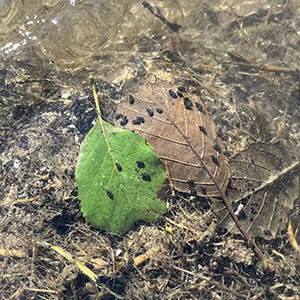Periphyton growth on allochthonous input in streams may lead to higher individual growth rates of the invasive New Zealand mud snail (Potamopyrgus antipodarum)

All claims expressed in this article are solely those of the authors and do not necessarily represent those of their affiliated organizations, or those of the publisher, the editors and the reviewers. Any product that may be evaluated in this article or claim that may be made by its manufacturer is not guaranteed or endorsed by the publisher.
Accepted: 25 May 2023
Authors
The aquatic, invasive New Zealand mud snail (Potamopyrgus antipodarum) exploits a variety of food sources. Here we examine the change in growth of snails that fed on periphyton colonizing leaf litter, wood, rock, and a control. Juveniles were grown in the lab on Spirulina algae powder (control) or periphyton grown on rock, leaf litter, or wood. Length was measured at the beginning of the experiment and after eight weeks. Snails grown on leaf litter increased in length more than twice as much as the control and the snails in the rock treatment, and the snails grown on wood showed an increase in length more than twice as much as snails in the rock treatment. This suggests that allochthonous material may contribute to a more nutritious food source for New Zealand mud snails and possibly aid in their invasion success.
Ethics Approval
Fabrizio Stefani, National Research Council, Water Research Institute (CNR-IRSA), Brugherio, ItalyHow to Cite

This work is licensed under a Creative Commons Attribution-NonCommercial 4.0 International License.






